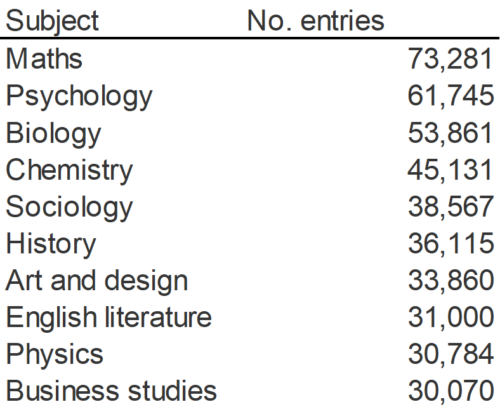At Datalab, we’re fond of the phrase ‘demography not geography’. We like to use it when pointing out that most differences between the regions, in terms of educational outcomes, can be explained by looking at the differences in the demographics of the pupil population in different areas.
But in this post, we’re just going to be talking about geography. We’ll be looking at how A-Level subject choice varies around the country, using publicly available data on students in state-funded schools aged 16-18 who completed A-Levels in 2021.
Which are the most popular subjects in each region ?
First of all, here’s a reminder of the most popular A-Level subject choices nationally.

The chart below shows the top ten choices in each region.
The top three choices were the same in every region except the East Midlands: maths, psychology and biology. The East Midlands wasn’t exactly radically different: the top three choices were psychology, maths and biology.
Things get rather more interesting when we look further down the lists.
Art and design was far more popular in the South East, North East, North West and South West – where it was in the top five choices – than in London and the West Midlands – where it was the tenth most popular choice.
In London, economics was the sixth most popular choice. But it didn’t even appear in the top ten for any other region. Similarly, geography was the sixth most popular subject in the South West, but barely broke the top ten in other regions.
Where are individual subjects most popular?
Now let’s flip things around and look at how the proportion of entries to each subject varies by area.
Economics and English language were the subjects with the highest variation by region.
As mentioned above, economics was very popular in London – nearly one in five studied the subject (18%) – but much less popular outside the East and South East. In the North East, for example, just 6% of students studied this subject.
On the other hand, English language was a fairly popular choice in much of the country, particularly in the north, but much less so in London and the South East; in the North East, 13% of students studied this subject, compared to just 1% in London and 4% in the South East.
A more granular approach
But looking at regions can mask variation at a more local level. So it’s worth drilling down more to look at the differences by local authority.
The chart below shows the top ten choices in each local authority. [1]
There’s a lot more variation at this level, but the top three choices nationally are popular in almost all LAs, particularly maths, which is in the top five choices in every LA except the Isle of Wight. Biology makes the top ten in every LA, and psychology likewise. Even so, some areas have more variation in subject choice than others. In Reading, for example, the top choice, maths, is studied by 65% of students. In Warrington, maths is also the top choice but is studied by just 21% of A-Level students.
As at the regional level, some topics are extremely popular in some areas but much less so elsewhere. Art and design, for example, is the number one choice in four LAs (Brighton and Hove, North East Lincolnshire, Portsmouth and Southampton). But in a third of LAs, it’s not even an top ten choice.
Summing up
This post has focused on A-Level subject choice. We’re well aware that not all students study A-Levels and hope to return to look at how other choices vary by area.
But, while the most popular A-Level choices are similar across the country, we have found some interesting local differences. Economics leaps out as the subject with most striking differences in popularity by region but it is by no means the only one.
We promised to focus on geography not demography, but it’s difficult to resist speculating about how these differences are related to differences in the characteristics and backgrounds of the pupils in these areas.
[1] We have excluded Knowsley because of the very small number of A-Level entries from this LA in 2021.






Looking at LA-level data, you also need to consider that the data is for where people are studying, rather than for where they live. Southampton has Art & Design top, but most students living in Southampton commute north to study in huge sixth form colleges outside the LA (notably Peter Symonds in Winchester, and Barton Peveril in Eastleigh). These colleges draw students from a huge region; students even commute from London to Peter Symonds.
Thanks Jenny, this is a good point and easily missed.
My concern is the popularity of Maths where there is a shortage of Maths teachers; is this popularity sustainable? Also why is the popularity of Maths not matched by the popularity in Physics?
Maybe because you don’t need physics to go into accountancy, business administration, data analysis, etc.
Hello both of you, thanks for your comments. The (un)popularity of physics is a subject close to my heart. I’ve got more to say about it than I can reasonably fit into a comment here, so I’ll restrict myself to a couple of points… I do think maths is often seen as a more universally useful subject than physics – or any science really. Plus students are often told that in order to study physics, they’ll also have to take maths and/or another science, but maths doesn’t tend to have any such restrictions. So I think physics can end up being taken mostly by students who are already pretty committed to a science/engineering career. But maths is a lot more open.
I will stop there before this comment becomes longer than the original post!